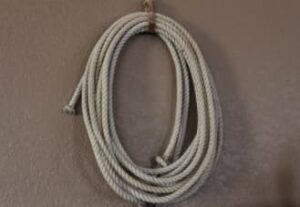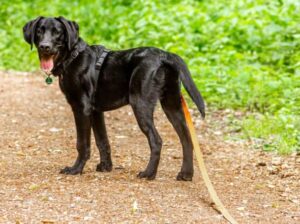Learning how to walk a dog on a longline is a skill that needs practice. Keeping your dog safe, ensuring no one gets tripped up and knowing how to control the line are important factors when using a longline.
Table of Contents
Why use a longline?
A longline is useful in many scenarios
- Training recall
- Sketchy recall
- Testing recall skills
- High distraction environments
- Allowing freedom with safety
- Dogs who come back but not all the way back
- New/unfamiliar environments where you may have to grab your dogs quickly
You could use a retractable lead instead, and although I don’t think they’re the work of the devil as long as they’re in the right hands, longlines ARE better.
Longlines force you to maintain focus on your dog because of the way you need to reel in and reel out the line. It’s not automatic like a retractable lead.
If you drop a longline there’s no harm done, no loud noise and no broken parts.
Longlines are generally wider than the tape or cord found on extendable leads, so if they do get tangled they do less physical damage. Although we still need to be careful using them.
Types of longline
Handle or no handle
Handles can snag on things if you’re trailing the line behind the dog, and if you’re using a long line correctly when you’re holding it, you should never get to the end of the line where the handle is. I always buy long lines without a handle or cut them off.
How long should a longline be?
I think between 5 to 10 metres (15 to 30 feet approx) is a good length. Anything shorter and you’re unlikely to get close enough to grab or stand on the lead before the dog moves away, any longer than 10 metres and it becomes awkward to use and carry.
What should the longline be made of?
All the options have pros and cons to them.
Lightweight nylon tape
Great for tiny dogs, usually really cheap to buy, and fits in a pocket easily.
Gets tangled quickly, not very durable.
Heavyweight webbing long line
Fairly inexpensive, better for medium/large dogs
Soaks up water and becomes heavy, and rough on hands
Webbing with a rubberised surface
Great for grip, easy to feed out and reel in
More expensive
Rope (Horse lunge lines)
Cheap and cheerful, heavyweight fittings.
Rope long lines can be heavy and cumbersome to carry
Biothane.
Biothane long lines are waterproof and incredibly durable
Slips through hands, better for trailing than holding, expensive
How to use a longline
Attach the longline to the back of the dog’s harness. Using a harness reduces the risk of neck injuries from whiplash, and using the back of the harness keeps the longline away from the dog’s feet and prevents tripping.
The line should be loosely coiled and look similar to a cowboy’s lasso.

These loops are held in one hand and unravel as the dog moves away from you. As he moves back, you pick up the slack and loop back into the hand holding the line.
This back and forth, reel out and reel in, keeps the line off the ground most of the time but remains tension free. Practice calling the dog back before you run out of line.
When your dog reliably comes back to you when you call them you can start letting the longline trail on the floor instead of you holding it. This gives you an emergency option to grab, or stand on, to stop your dog and reel them back in.
Issues to avoid when using a longline
Be aware that it can become a trip hazard for other people. Call them back to you and keep hold of the longline whilst there are other people around.
Lots of people will assume you’ve dropped it when you let it trail behind your dogs. They will grab the lead and hand it back to you expecting gratitude for, in their minds, stopping your dog from running away.
When a dog on a trailing longline is playing with other dogs it has the risk of wrapping around the dog’s legs. A shorter, chunkier longline is better in a group to minimise injuries.
If the longline is tangling when you’re holding it, drop the line and grab it near the dog’s collar and re-loop it back up. Trying to detangle from your end whilst your dog has free rein on the other 30 feet just makes life difficult.
Don’t knot your longline. It might seem like a good idea for grip but if they run away from you the knots will rip through your hands damaging them much more than a rope burn from an unknotted line. Stepping on a knotted line is more likely to trip you up and the knots collect dirt when trailing on the ground.
Are long lines good for dogs?
Longlines are great for dogs! They are a stepping stone to complete freedom when teaching recall.
What’s the best long line for dogs?
There are lots of options but the rubberised webbing longlines are great for grip.
How long should a dog’s longline be?
5 to 10 metres (15 to 30 feet approx) is the best length. Longer lines become difficult to manage, shorter lines don’t allow your dog to be far enough from you to practice recall or explore further away from you whilst still safe.
How do you keep a long line from tangling
Use nice big loops to coil your longline and try to re-loop it back onto your hand as your dog comes back to you. This way the line is never on the ground long enough to tangle.
How do you carry a long leash?
Once your training session is finished you can loop it back up and clip it to a belt to carry home. Longlines are like wired headphones, if you stuff it in a bag or pocket then it’s going to get tangled.
AFFILIATE DISCLAIMER
The dog walking coach website is supported by our visitors. Some of the product links on this website are through affiliate schemes such as Amazon. This means that I earn a small commission if you choose to purchase something at no extra cost to yourself.
